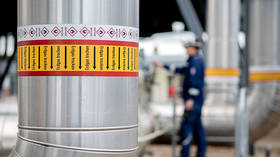Eight new planets found in ‘Goldilocks' zone, 2 hailed as 'most Earth-like'

Astronomers have discovered eight new planets in the so-called "Goldilocks" habitable zone, orbiting at a distance where liquid water, and possibly life, can exist. Two planets are said to be the most similar to Earth of any known exoplanets to date.
"Most of these planets have a good chance of being rocky,
like Earth," Guillermo Torres, the lead scientist from the
Harvard-Smithsonian Center for Astrophysics (CfA) in Cambridge,
US, told a meeting of the American Astronomical Society in
Seattle.
According to the astronomers, the two most Earth-like planets of
the group are called Kepler-438b and Kepler-442b. Both orbit red
dwarf stars that are smaller and cooler than the Sun. Their daily
routine is as follows: Kepler-438b circles its star every 35
days, while Kepler-442b completes one orbit every 112 days.
For those who missed it- Kepler's 'Hall of Fame' of small (<2x Earth-size) habitable zone verified exoplanets #aas225pic.twitter.com/9z7ofLB9uG
— NASA Kepler (@NASAKepler) January 7, 2015
According to the scientists' calculations, with a diameter just
12 percent bigger than Earth, Kepler-438b boasts a 70-percent
chance of being rocky. Its closest rival, Kepler-442b, is about
one-third larger than Earth, but still has a 60-percent chance of
being rocky.
To be in the habitable zone, an exoplanet must receive about as
much sunlight as Earth. Too much and any water would boil away as
steam, while too little means it will freeze solid, scientists
explain. "For our calculations we chose to adopt the broadest
possible limits that can plausibly lead to suitable conditions
for life," Torres said.
READ MORE: 100mn stars in 1.5bn pixels: Hubble takes ‘sharpest ever’ image of Andromeda galaxy
Kepler-438b gets about 40 percent more light than Earth. To
compare, Venus, the second planet from the sun, gets twice as
much solar radiation as Earth. So, the team believes, Kepler-438b
enjoys a 70 percent probability of being in the habitable zone of
its star.
Kepler-442b gets about two-thirds as much light as Earth. The
scientists give the champion a 97 percent chance of being in the
habitable zone.
Remember – the @NASAKepler field of view is only a tiny slice of our galaxy. There are a LOT of planets out there! pic.twitter.com/prjNujuoKB
— Jason Major (@JPMajor) January 6, 2015
Although the scientists admit they don't know for sure whether
any of the planets in their sample are "truly
habitable," they are being referred to as "promising
candidates." The paper reporting the research in detail has
been published in The Astrophysical Journal.
Prior to the latest discovery, the two most Earth-like planets
known were Kepler-186f, which is 1.1 times the size of Earth and
reaps 32 percent as much light, and Kepler-62f, 1.4 times the
size of Earth, which gains 41 percent as much light.

The latest discoveries were made with the help of NASA’s
trailblazing Kepler Space Telescope, which was launched to hunt
for Earth-sized planets outside the solar system. Since 2009,
astronomers have discovered hundreds of exoplanets through the
telescope alone; most of them are believed to be planets ranging
between the size of Earth and Neptune (which itself is four times
the size of Earth).
As with many Kepler discoveries, the newly found planets are
distant enough to make additional observations strenuous.
Kepler-438b is 470 light years from Earth, while Kepler-442b is
1,100 light years away.
Since the planets were too small to be confirmed by measuring
their masses, scientists said they used a computer program called
Blender to determine that they are statistically likely to be
planets. The same method has been used previously to
"validate some of Kepler’s most iconic finds, including the
first two Earth-size planets around a sun-like star and the first
exoplanet smaller than Mercury."












